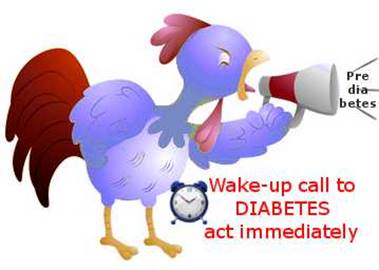
2. Prediabetes causes Increased Risk for All-Cause Mortality |

![]() The health risks and mortality associated with prediabetes seem to increase at the lower cut-off point for blood sugar levels recommended by some guidelines, finds a large study published in
The BMJ.
The health risks and mortality associated with prediabetes seem to increase at the lower cut-off point for blood sugar levels recommended by some guidelines, finds a large study published in
The BMJ.
![]() Prediabetes is a “pre-diagnosis” of diabetes — when a person’s blood glucose level is higher than normal, but not high enough to be considered diabetes. If left untreated, prediabetes can develop into type 2 diabetes. Doctors define prediabetes as impaired fasting glucose (higher than normal blood sugar levels after a period of fasting), impaired glucose tolerance (higher than normal blood sugar levels after eating), or raised hemoglobin levels. But the cut-off points vary across different guidelines and remain controversial.
Prediabetes is a “pre-diagnosis” of diabetes — when a person’s blood glucose level is higher than normal, but not high enough to be considered diabetes. If left untreated, prediabetes can develop into type 2 diabetes. Doctors define prediabetes as impaired fasting glucose (higher than normal blood sugar levels after a period of fasting), impaired glucose tolerance (higher than normal blood sugar levels after eating), or raised hemoglobin levels. But the cut-off points vary across different guidelines and remain controversial.
![]() A team of researchers from the affiliated Hospital at Shunde, Southern Medical University in China analyzed the results of 53 studies involving over 1.6 million individuals to shed more light on associations between different definitions of prediabetes and the risk of cardiovascular disease, coronary heart disease, stroke, and all-cause mortality. They found that prediabetes, defined as impaired fasting glucose or impaired glucose tolerance, was associated with an increased risk of cardiovascular disease and all-cause mortality. The risk increased in people with a fasting glucose concentration as low as 100 mg/dL— the lower cut-off point according to ADA criteria.
A team of researchers from the affiliated Hospital at Shunde, Southern Medical University in China analyzed the results of 53 studies involving over 1.6 million individuals to shed more light on associations between different definitions of prediabetes and the risk of cardiovascular disease, coronary heart disease, stroke, and all-cause mortality. They found that prediabetes, defined as impaired fasting glucose or impaired glucose tolerance, was associated with an increased risk of cardiovascular disease and all-cause mortality. The risk increased in people with a fasting glucose concentration as low as 100 mg/dL— the lower cut-off point according to ADA criteria.
![]() Raised hemoglobin A1C levels, over 5.6 % were also associated with an increased risk of cardiovascular disease and coronary heart disease, but not with an increased risk of stroke and all-cause mortality. These results support the lower cut-off point for impaired fasting glucose according to ADA criteria as well as the incorporation A1C in defining prediabetes. At present, lifestyle modification is the mainstay management for people with prediabetes.
Raised hemoglobin A1C levels, over 5.6 % were also associated with an increased risk of cardiovascular disease and coronary heart disease, but not with an increased risk of stroke and all-cause mortality. These results support the lower cut-off point for impaired fasting glucose according to ADA criteria as well as the incorporation A1C in defining prediabetes. At present, lifestyle modification is the mainstay management for people with prediabetes.
![]() Chief investigator Yunzhao Hu, MD, PhD, professor in the department of cardiology at First People’s Hospital of Shunde in Foshan, China, added that, “the risk increased in people with fasting glucose levels as low as 100 mg/dL and with HbA1c of 5.7%. So we believe people with prediabetes should be followed up clinically and keep a healthy lifestyle. Plus, we need to develop models for risk stratification in people with prediabetes, and we need to find a drug treatment that can prevent CVDs in them.”
Chief investigator Yunzhao Hu, MD, PhD, professor in the department of cardiology at First People’s Hospital of Shunde in Foshan, China, added that, “the risk increased in people with fasting glucose levels as low as 100 mg/dL and with HbA1c of 5.7%. So we believe people with prediabetes should be followed up clinically and keep a healthy lifestyle. Plus, we need to develop models for risk stratification in people with prediabetes, and we need to find a drug treatment that can prevent CVDs in them.”
For enquiries info@jothydev.net.
Please visit: jothydev.net | research.jothydev.com | diabscreenkerala.net | jothydev.com/newsletter
